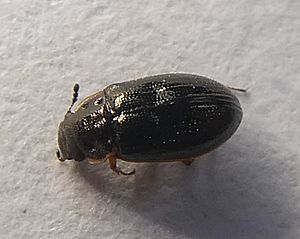Horelophus walkeri facts for kids
Quick facts for kids Horelophus walkeri |
|
|---|---|
 |
|
| Conservation status | |
 Nationally Endangered (NZ TCS) |
|
| Scientific classification | |
| Genus: |
Horelophus
|
| Species: |
walkeri
|
Horelophus walkeri is a tiny water scavenger beetle that lives only in New Zealand. This means it is endemic to New Zealand, found nowhere else in the world!
Contents
About the Horelophus walkeri Beetle
This special beetle was first described in 1913 by a scientist named Armand d'Orchymont. He studied two beetles that were found in Reefton, New Zealand.
The Horelophus walkeri beetle is quite small, usually between 2.1 and 3.1 millimeters long. That's about the size of a small ant! Its body is shiny and can be brown or black. The part behind its head, called the pronotum, and its hard wing covers, called the elytra, have edges that are a pale, see-through brown color.
Its small eyes are light-colored and stick out a little from its head. If you look closely, you'd see tiny, shallow dents all over its head, the part behind its head, and its wing covers. The wing covers also have a unique dip or hollow area. This beetle is so unique and has such old features that it's placed in its very own group, called the Horelophinae subfamily.
Where It Lives and Its Home
This beetle has been found in sunny spots near waterfalls in areas like Nelson, Buller, and Marlborough.
Some specific places in Marlborough include Dead Horse Creek, which is close to Canvastown, and small streams that flow into the Pelorus River, near Pelorus Bridge. In Nelson, these beetles have been collected from Deepwater Creek, near Lyell, and from streams that flow into the Wangapeka and Owen Rivers.
All the places where Horelophus walkeri has been found are fast-flowing, clear, and cool waterways. The riverbeds in these areas are made of fine, soft rocks. Most of these locations are in beech forests where the tree cover is open, allowing sunlight to reach the water. You can often spot Horelophus walkeri walking on wet rocks or hiding in moss, cracks, and shady spots near waterfalls where the water sprays. Unlike some other water scavenger beetles that live in similar places, this beetle usually walks on wet rocks instead of being fully underwater.
How It Behaves
Horelophus walkeri likes to hide in moss and small cracks in the areas near waterfalls where water splashes. Scientists think these beetles probably eat algae, which is a type of plant-like growth, from the smooth, wet rocks in these areas.
While adult water scavenger beetles usually eat plants or dead things, their young, called larvae, are meat-eaters. Since these beetles are not found in places with thick tree cover, it's thought they might use polarized light. This is a special kind of light that reflects off the wet rocks under waterfalls, helping them find good places to live. Also, their long wings suggest that they are able to fly.
Protecting This Beetle
Not many Horelophus walkeri beetles were collected until 2012. Doing more surveys, which means looking for and studying these beetles, can help us understand exactly what kind of home they need to survive.
Currently, this beetle has not been found in any river areas within Nelson City. This might mean that they cannot live well in city environments. In 2012, Horelophus walkeri was added to the list of beetles in New Zealand that are considered nationally endangered. This means they are at risk and need our help to protect them and their habitats.


